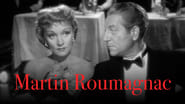boblipton
Here's a movie that was clearly produced on star power: Marlene Dietrich! Jean Gabin! She's a beautiful woman in small town, a "merry widow" with several beaux to her string, waiting for the rich, ugly wife of one of them to die so he'll marry her. She runs into Gabin, who's a construction contractor, and of course they fall in together, much to the audience's lack of surprise, and with many a shot of Marlene's legs. However, as her past and their present are revealed, there is anger and snarling and things go downhill, with lots of Gabin snarling and Dietrich to-hell-with-it shouting.The director Georges Lacombe may be remembered as a director of early Clouzot scripts, but he started off as one of the Surrealists in Paris in the 1920s. By the end of the 1930s he was a thoroughly commercial director whose big-screen career petered out in the late 1950s, but who continued to direct made-for-TV movies into the 1970s. This move has a 1930s air to it; one would think the War had never happened.
writers_reign
There's a trivia question in here somewhere albeit one serious buffs will find too easy: what are the similarities and differences between Martin Roumagnac and Les Portes de la nuit. Similarities: Gabin left France in 1940 for Hollywood; his ex co-star and ex-lover Michele Morgan was already there but instead of re-igniting their affair he started another one, with Marlene Dietrich, a somewhat heavier hitter than Morgan. Back in France after the war he commissioned top writer-director team Jacques Prevert and Marcel Carne to come up with a film to co-star himself and Dietrich; ideally it should be a bit special because his last film, L'Imposteur, had been shot in 1942, albeit not released until 1944. He was choosing wisely,Prevert and Carne had supplied him with two of his greatest pre-war hits, Le Quai des brumes and Le Jour se leve. They rose to the challenge in the shape of Les Portes de la nuit, commissioned Sandy Trauneur to replicate the Barbes-Rochechouart Metro in the studio and were ready to go when Gabin pulled the plug leaving them all dressed up and nowhere to go. Gabin turned instead to Georges Lacombe, a journeyman director with a few respectable credits but not really in the same league as Carne. Those are the similarities, but what about the differences: Well, both films were colossal flops both with the critics and at the box office. Today, half a century later Les Portes de la nuit is an acknowledged masterpiece whilst Martin Roumagnac is an acknowledged ... flop. So, what is is about? Well you might ask; in a provincial French town Marlene Dietrich is a hooker turning tricks - and I kid you not - in a room above a shop ostensibly selling birds as pets. An early scene may or may not be subtle in that Dietrich is seen pushing a bicycle in the town square though whether the expression she's the town bicycle (everybody in town has ridden her) was current in 1946 your guess is as good as mine. Gabin is, of course, surprise, surprise, the 'nice' guy who falls for her with no idea of how she pays the rent. It ends in tears, of course, as these things always do and there's a nice 'borrowing' from The Great Gatsby in the way Gabin - who has been tried and exonerated for killing Dietrich - gets his. I doubt very much if I would want to sit through this again but then what do I know.
Bob Taylor
I thoroughly enjoyed the acting in this. Gabin is in good form as a decent contractor who gets mixed up with a tarty Dietrich. He keeps his star luster under control. Marcel Herrand as the oily consul de Laubry is impressive, just as he was as the thug in Les Enfants du Paradis. Jean d'Yd plays Dietrich's uncle as a shambling Monsieur Hulot figure; he's really wonderful to watch. His last scene testifying at the trial is very touching. Margo Lion plays Gabin's sister superbly; she'll be remembered after most of the story fades from memory.Marlene Dietrich and her slow sensuous drawl--what can I say about her? I found her as convincing in French as she was in German and English. She's going to win your heart even as you deplore her lack of ethics. Finally, some excellent camera-work from Roger Hubert, who shot Les Enfants du Paradis and Les Visiteurs du soir for Carne.
silverauk
Georges Lacombe makes a somewhat light interpretation of this social and psychological drama by Pierre-rené Wolf. The court at the end with its "avocat" and "ministère public" deliver us quite sensational dialogues and this second part of the movie is the most interesting; the end of the movie is anti-climax but is in the line of the Martin roumagnac and his adversary. Jean Gabin and Marlene Dietrich save the film for our memory but Marlene dietrich should have been more developed.




